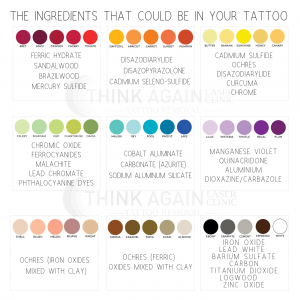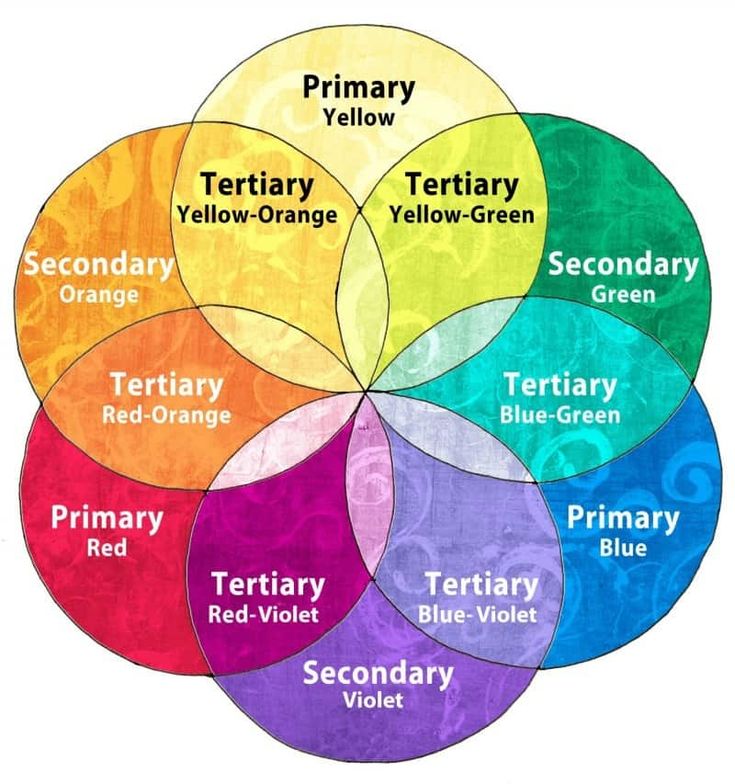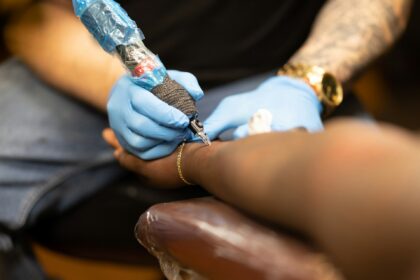The art of tattooing stands as a timeless expression of individuality and creativity. Mastering the craft requires not just skill but a deep understanding of custom tattoo colors and the pivotal role of ink mixing. Achieving the perfect design goes beyond mere application; it delves into the science of color theory and the nuances of how skin tones influence tattoo appearance. Artists who harness these elements can elevate their work, ensuring each piece not only resonates with vibrancy but also harmonizes with the canvas of the skin. This introduction sets the stage for an exploration into the vibrant world of tattoo ink mixology, where precision meets artistry.
Understanding Tattoo Ink Components
It’s crucial to understand that the magic of a tattoo lies not just in the skill of the artist but also in the quality of the ink they use. Each ink contains pigments, which are the heart of the color, and a carrier solution that ensures these pigments distribute evenly across the skin. This blend is not just about aesthetics; it’s about the integrity of the artwork and the safety of the canvas – the skin. Opting for high-quality, safe inks is more than a choice; it’s a responsibility. These inks ensure that the vibrancy of the tattoo remains through years, reducing the risk of fading and skin reactions.
Moreover, the understanding of tattoo ink components extends to recognizing the various types of pigments used and their compatibility with different skin types. Some pigments may offer brighter colors but pose higher risks of allergic reactions. Others might be safer but less vivid. The carrier solution, often a blend of ethyl alcohol, distilled water, or glycerin, plays a pivotal role in this balance, affecting the ink’s viscosity and how it heals.

An artist’s ability to choose the right ink, considering both the creative and health implications, sets the foundation for a tattoo that not only captures the eye but also stands the test of time. This knowledge also guides artists in advising clients on the best colors and compositions that will work for their specific skin tones, enhancing the overall tattoo appearance.
The Basics of Color Theory and the Color Wheel
Color wheel play a crucial role in the mastery of tattoo artistry. This foundational knowledge enables artists to blend and create custom tattoo colors with confidence and precision. The color wheel, a visual representation of colors arranged according to their chromatic relationship, serves as an indispensable tool for artists. Understanding primary, secondary, and tertiary colors unveils the potential for an infinite palette of shades, essential for tattoo color blending.
By applying color theory, artists can predict how different colors interact, how they complement or contrast with each other, and how they influence the perception of depth and movement in a design. This theory also informs artists about the psychological effects colors have, adding another layer of meaning to their work.

Moreover, considering skin tones is paramount when selecting colors, as the ink will blend with the natural pigment of the skin, affecting the final appearance. An artist’s ability to navigate these considerations ensures that the tattoo not only looks vibrant on the day of its application but also ages gracefully with the skin.
Color theory and the color wheel are more than just artistic concepts; they are essential tools that enable tattoo artists to push the boundaries of their creative expression, ensuring every piece they create is a harmonious blend of art, science, and personal storytelling. This understanding not only elevates the quality of the tattoo but also enhances the connection between the artist, the artwork, and the wearer.
Tools and Supplies Needed for Ink Mixing
It’s essential to delve into the specifics that make the process both effective and safe. Central to this is the use of sterile equipment. Every tool that comes into contact with the ink or the skin must be sterilized to prevent infection and cross-contamination. This includes needles, mixing containers, and stirring implements. Disposable gloves are a must, not only for hygiene but also to protect the artist’s skin from absorbing pigments and chemicals.
A disposable palette serves as an ideal surface for mixing colors. It ensures that artists can blend inks without the risk of cross-contamination between shades. Additionally, the palette’s disposability means that cleanup is quick and straightforward, maintaining a sterile work environment.
Distilled water is often the medium of choice for thinning ink or creating washes. Its purity guarantees that no external contaminants affect the ink’s quality or safety. For artists seeking to adjust the viscosity or transparency of their inks without altering the color, distilled water is indispensable.
High-quality tattoo inks themselves are, of course, the foundation of the mixing process. Selecting inks from reputable manufacturers ensures that the pigments are vibrant, consistent, and, most importantly, safe for skin application. Artists often stick to one brand to maintain color consistency across their palette.
The significance of understanding and utilizing these tools and supplies cannot be overstated. They not only facilitate the creation of unique, custom colors but also ensure that the tattooing process adheres to the highest standards of safety and professionalism. By investing in the right equipment and materials, artists set themselves up for success, creating tattoos that are beautiful, lasting, and safe for their clients.
This detailed approach to selecting and using tools and supplies for ink mixing reflects the meticulous nature of tattoo artistry. It underscores the importance of precision, hygiene, and quality in every step of the tattooing process, from initial concept to final application.
Step-by-Step Guide to Mixing Tattoo Ink
Precision and patience are key. The process begins with understanding the color outcome you aim to achieve. Using a color wheel as a reference can help artists visualize the end result when mixing primary, secondary, and even tertiary colors.
- Starting with Lighter Colors: Begin by pouring a small amount of the lighter color ink into your mixing container. Lighter shades act as a base and are easier to darken incrementally than attempting to lighten a darker shade.
- Adding Darker Colors Gradually: Introduce the darker color ink drop by drop into the container with the lighter ink. Stir gently but thoroughly after each addition to assess the color blend. This controlled approach allows for precise adjustment and avoids overshooting the desired hue.
- Adjusting with White or Black Ink: To fine-tune the shade, you might add a tiny amount of white ink to lighten or black ink to darken the mixture. Remember, these adjustments should be minimal to maintain the color’s integrity.
- Testing on Practice Skin: Before applying the custom mix to skin, test it on a piece of practice skin. This step is crucial for seeing how the ink settles and appears under tattooing conditions.
- Maintaining Consistency: Ensure the consistency of the ink is suitable for the tattooing technique you plan to use. If the ink is too thick, it may not flow well from the needle, and if too thin, it may not provide the saturation needed. Distilled water can be used to thin the ink if necessary, but do so sparingly to avoid diluting the pigment too much.
- Sterilization and Safety: Throughout the mixing process, maintaining a sterile environment is paramount. Use sterile containers and tools to mix and store your ink, and always wear disposable gloves to prevent contamination.
This detailed guide underscores the meticulousness required in ink mixing, emphasizing the importance of gradual adjustments and constant evaluation. Each step, from selecting the initial colors to testing the final mix, plays a crucial role in achieving the perfect custom ink blend that will bring a tattoo design to life with depth, vibrancy, and precision.
Special Considerations for Color Blending
Color blending isn’t just about mixing; it’s about understanding the interplay of colors to achieve the desired effect on the skin.
- Understanding Skin Tones: The artist must consider the client’s skin tone as a canvas that will interact with the ink. Darker skin tones might require more saturated colors to ensure visibility, while lighter skin tones can display a wide range of colors more vividly. This consideration ensures the tattoo looks natural and stands out appropriately on various skin types.
- The Role of Dilution: Dilution with distilled water or specific tattoo diluents can soften the intensity of colors, allowing for the creation of subtle gradients and shades. This technique is particularly useful in styles like watercolor tattoos or when aiming for a soft, realistic shading effect.
- Layering for Depth: Applying colors in layers can add depth and dimension to the tattoo. Starting with lighter shades and gradually adding darker tones can create a dynamic visual effect, giving the tattoo life and movement.
- Healing and Fading Considerations: It’s crucial to educate clients on the healing process and how it might affect the tattoo’s appearance. Some colors may fade or shift slightly as the tattoo heals, so choosing and blending colors that maintain their integrity over time is essential.
- Practicing and Experimenting: The best way to master color blending is through practice and experimentation. Trying out different color combinations on practice skins or partaking in continuing education courses can refine an artist’s blending skills.
This nuanced understanding of color blending showcases the depth of knowledge and skill required to execute a stunning tattoo. It’s not merely about the technical act of mixing inks but involves a deep comprehension of how colors work together, how they’re perceived on different skin tones, and how they change over time. Mastery of these considerations allows tattoo artists to elevate their work from simple designs to intricate, lifelike art that resonates with both the wearer and the viewer.
Conclusion
The art of mixing tattoo ink is an intricate blend of science, creativity, and technique. From the initial selection of high-quality, safe inks to the meticulous process of color blending that takes into account skin tones and color theory, each step is pivotal in creating tattoos that not only captivate visually but also stand the test of time.
Understanding tattoo ink components, mastering the color wheel, utilizing the right tools and supplies, and applying special considerations for color blending, highlights the depth of expertise required in this craft. For artists, the process is a continuous learning curve, driven by experimentation and a dedication to excellence. Achieving the perfect custom ink mix is not just about the end result; it’s about ensuring safety, vibrancy, and longevity of the artwork.





